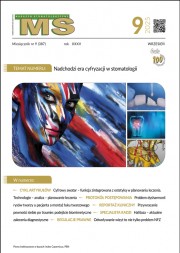Dostęp do tego artykułu jest płatny.
Zapraszamy do zakupu!
Cena: 12.50 PLN (z VAT)
Kup artykuł
Po dokonaniu zakupu artykuł w postaci pliku PDF prześlemy bezpośrednio pod twój adres e-mail.
MS 2021; 1: 44-48.
Jakub Kwiatek, Aleksandra Jaroń, Michał Kwiatek, Grzegorz Trybek
Streszczenie
Przedoperacyjne badanie podmiotowe, przedmiotowe oraz analiza badań dodatkowych pacjenta stanowią istotny element procesu diagnostyczno-leczniczego w praktyce stomatologa, szczególnie chirurga stomatologicznego. Pozwala ona przy uwzględnieniu planowanego leczenia odpowiednio zaplanować postępowanie okołooperacyjne i zmniejszyć ryzyko wystąpienia powikłań okołozabiegowych.
Abstract
Pre-operative anamnesis, physical examination and analysis of additional examinations of the patient are an important part of the diagnostic and therapeutic process in dental practice, especially in the practice of oral surgeon. It allows, taking into account the treatment plan, to plan the perioperative treatment and reduce the risk of perioperative complications.
Hasła indeksowe: chirurgia stomatologiczna, diagnostyka laboratoryjna, cukrzyca, hemostaza, witamina D, osteoporoza, planowanie przedoperacyjne
Key words: oral surgery, laboratory diagnostics, diabetes, haemostasis, vitamin D, osteoporosis, preoperative planning
PIŚMIENNICTWO
- Rusińska A, Płudowski P, Walczak M i wsp. Vitamin D supplementation guidelines for general population and groups at risk of vitamin D deficiency in Poland. Recommendations of the Polish Society of Pediatric Endocrinology and Diabetes and the Expert Panel with participation of National Specialist Consultants and Representatives of Scientific Societies. 2018 update. Front Endocrinol (Lausanne). 2018; 9: 246.
- Gani LU, How CH. Vitamin D deficiency. Singapore Med J. 2015; 56(8): 433-437.
- Płudowski P, Karczmarewicz E, Bayer M i wsp. Practical guidelines for the supplementation of vitamin D and the treatment of deficits in Central Europe – recommended vitamin D intakes in the general population and groups at risk of vitamin D deficiency. Endokrynol Pol. 2013; 64(4): 319-327.
- Haderslev KV, Jeppesen PB, Sorensen HA i wsp. Vitamin D status and measurements of markers of bone metabolism in patients with small intestinal resection. Gut. 2003; 52(5): 653-658.
- Bouillon R, Carmeliet G, Verlinden L i wsp. Vitamin D and human health. Lessons from vitamin D receptor null mice. Endocr Rev. 2008; 29(6): 726-776.
- Hunter D, De Lange M, Snieder H i wsp. Genetic contribution to bone metabolism, calcium excretion, and vitamin D and parathyroid hormone regulation. J Bone Miner Res. 2001; 16(2): 371-378.
- Moreira ML, Neto LV, Madeira M i wsp. Vitamin D deficiency and its influence on bone metabolism and density in a Brazilian population of healthy men. J Clin Densitom. 2018; 21(1): 91-97.
- Trybek G, Aniko-Włodarczyk M, Kwiatek J i wsp. The effect of vitamin D3 on the osteointegration of dental implants. Balt J Health Phys Act. 2018; 10(4): 25-33.
- Sözen T, Özışık L, Başaran NÇ. An overview and management of osteoporosis. Eur J Rheumatol. 2017; 4(1): 46-56.
- Bijelic R, Milicevic S, Balaban J. Risk factors for osteoporosis in postmenopausal women. Med Arch. 2017; 71(1): 25-28.
- de Souza MP. Osteoporosis diagnosis and treatment. Rev Bras Ortop. 2010; 45(3): 220-229.
- Preuss O, Jaroń A, Aniko-Włodarczyk M i wsp. Zastosowanie fibryny bogatopłytkowej po ekstrakcji zęba w zapobieganiu wystąpieniu BRONJ. Med Trib Stomatol. 2019; 11: 18-27.
- Otto S, Abu-Id MH, Fedele S i wsp. Osteoporosis and bisphosphonates-related osteonecrosis of the jaw. Not just a sporadic coincidence. A multi-centre study. J Craniomaxillofac Surg. 2011; 39(4): 272-277.
- Villa A, Castiglioni S, Peretti A i wsp. Osteoporosis and bisphosphonate-related osteonecrosis of the jaw bone. ISRN Rheumatol. 2011; 2011: 654027.
- Aniko-Włodarczyk M, Trybek G. Pacjent z cukrzycą w praktyce stomatologicznej. Mag Stomatol. 2019; 3: 90-92.
- Cukrzyca w liczbach, [online:] https://pacjent.gov.pl/artykul/cukrzyca-w-liczbach [dostęp: 25.05.2020].
- Mellado-Valero A, Ferrer García JC, Herrera Ballester A i wsp. Effects of diabetes on the osseointegration of dental implants. Med Oral Patol Oral Cir Bucal. 2007; 12(1): E38-43.
- Löe H. Periodontal disease. The sixth complication of diabetes mellitus. Diabetes Care. 1993; 16(1): 329-334.
- Jaroń A, Preuss O, Grzywacz A i wsp. Zabiegi chirurgii implantologicznej jako powszechnie stosowana procedura rehabilitacji układu stomatognatycznego u pacjentów z cukrzycą. Diabetol Dypl. 2020; 17(3): 1-4.
- Polskie Towarzystwo Diabetologiczne. Zalecenia kliniczne dotyczące postępowania u chorych na cukrzycę 2020. Stanowisko Polskiego Towarzystwa Diabetologicznego. Diabetol Prakt. 2020; 6(1).
- Chojnowski K, Treliński J. Laboratoryjna ocena hemostazy, [online:] https://podyplomie.pl/wiedza/wielka-interna/740,laboratoryjna-ocena-hemostazy [dostęp: 12.2020].
- Aniko-Włodarczyk M, Preuss O, Metlerski M i wsp. Hemostaza w chirurgii stomatologicznej. Med Trib Stomatol. 2017; 6: 20-27.
- Mauprivez C, Khonsari RH, Razouk O i wsp. Management of dental extraction in patients undergoing anticoagulant oral direct treatment. A pilot study. Oral Surg Oral Med Oral Pathol Oral Radiol. 2016; 122(5): e146-e155.
- Fillmore WJ, Leavitt BD, Arce K. Dental extraction in the thrombocytopenic patient is safe and complications are easily managed. J Oral Maxillofac Surg. 2013; 71(10): 1647-1652.
- Badanie hemostazy: osoczowy układ krzepnięcia i zaburzenia dotyczące płytek krwi. W: D.J. Meyer, J.W. Harvey. Diagnostyka laboratoryjna w weterynarii. Interpretacja wyników, wartości referencyjne, opisy przypadków klinicznych, algorytmy diagnostyczne. Wyd. 1 pol. A. Winnicka (red.). A. Cywińska (tłum.). Wrocław 2013; s. 93-110, [online:] https://edraurban.pl/ssl/book-sample-file/diagnostyka-laboratoryjna-w-weterynarii/pdf/093_110_r06_veterinarylabmed.pdf [dostęp: 8.02.2019].
- Niemirowicz K, Żelazowska-Rutkowska B, Wysocka J i wsp. Zaburzenia liczby płytek krwi. Diagn. Lab. 2012; 48(4): 455-460.














